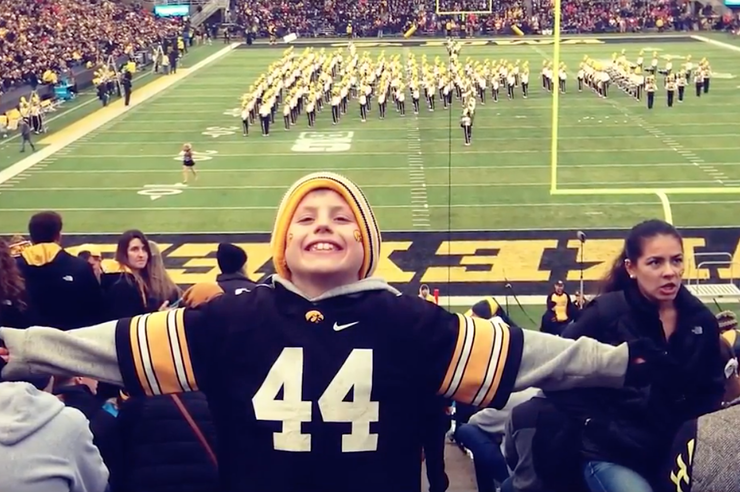Offering Iowa infant normalcy during extraordinary times

After months of trips back and forth between the local doctor and emergency room, Kelli and Brandon Bartleson of Nevada, Iowa, knew their infant daughter, Jaylee, was sicker than anyone thought. Jaylee was constantly congested and had difficulty breathing.
“We were in the emergency room five times between November 2018 and January 2019,” Kelli says. “Each time, we were sent home and told to just suction her out.”
“I think the medical staff just thought we were nervous first-time parents,” says Brandon.
One doctor in her hometown diagnosed her recurring congestions as a mild case of pneumonia, while another thought she might have leukemia. Tests for both conditions came back negative.
An episode in January resulted in Jaylee going in for magnetic resonance imaging (an MRI) but the family was again sent home.
“The next morning I received a call from one of the pediatricians who had been working with Jaylee,” Kelli says. “One of the nurses in the clinic, who happened to be our neighbor, mentioned she had seen an ambulance at our house and wondered if Jaylee was OK. He was calling to check in.”
The pediatrician looked at Jaylee’s MRI images, she says, and was stunned that they’d been sent home.
“He said it hit him like a bus,” Kelli says. “At the bottom of the image was a notation that Jaylee’s heart looked enlarged.”
Jaylee was sent for an echocardiogram, which showed her left ventricle was pumping out only 20% of the blood volume it should have been. The family was sent to University of Iowa Stead Family Children’s Hospital, where Jaylee was diagnosed with cardiomyopathy, a disease of the heart muscle that hinders the heart’s ability to pump blood.
Diagnosing the disease in infants and toddlers can be tough, says Aditya Badheka, medical director of the pediatric intensive care unit (PICU) and pediatric ECMO director at UI Stead Family Children’s Hospital.
“The signs that suggest lower heart function in babies can be subtle,” he says. “Therefore, it becomes very difficult to diagnose.”
Jaylee was admitted to UI Stead Family Children’s Hospital and placed on the heart transplant list. To help her heart function, she was attached to a left ventricle assist device (LVAD), a mechanical pump that helps to pump blood forward. For many patients as young as Jaylee, an out-of-body LVAD would mean bed rest until a donor heart became available.
Jaylee and her medical team had other plans.
“We were trying to keep her stable, but also give her as much of a normal baby life as we could,” Badheka says. “What we were trying to do is not restrict her. We wanted to keep her safe and let her grow, all the while keeping in mind she is on a life-support device.”
University of Iowa Stead Family Children’s Hospital primary and specialty care is provided by experts from all medical specialties, attracting patients from around the world. Pediatric medical services involved in Jaylee’s care include:
Caring for a patient while waiting for a heart transplant is a large, collaborative effort. A full team of pediatric specialists worked with Jaylee during this time, including cardiologists and cardiothoracic surgeons, the heart transplant team, critical care, nurses, anesthesia, occupational therapy, and child life.
“Yes, she was sick and dependent on life-supporting technology, but she could do many ‘normal’ things while on the LVAD, and it’s been shown to help with recovery post-transplant: patients have better strength and more muscle tone,” Badheka says.
In older patients, the LVAD is surgically implanted near the patient’s heart and the patient is able to go home and move freely. For babies like Jaylee, however, the machine is connected externally, with catheter-like tubes called cannula extending from the device up into the heart chambers. Patients are required to remain in the hospital and be monitored. Keeping her still wasn’t an option, says Kelli.
“We were sitting her up daily, getting her moving, and she just kept it up,” Kelli says. “She really loves her music and really dances around to it.”
Badheka says that despite having been connected to the LVAD, Jaylee continued to thrive as a typical infant would.
“She was dependent on that device, she needed it to stay alive,” he says. “But when you see her and all she was doing, she is a normal kid.”
Jaylee received a new heart in April and was back home in June, just a few weeks before her July 3 birthday.
Kelli credits Jaylee’s care team with her daughter’s success. “Pediatric heart transplantation requires highly specialized skills. Every member of our team is exceptional at what they do,” says Jaylee’s cardiothoracic surgeon, Dr. Marco Ricci.
“She’s done amazing things in the months since this started,” Kelli says. “I’m not going to lie, there were many nights I wondered if we would be coming home with our baby. But here we are, home as a family of three.”





